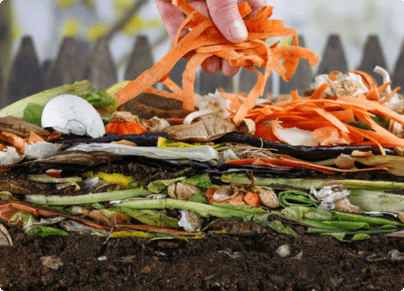Leveraging the Waste Stream For Economic Development
Reducing waste and recycling right isn’t just advantageous for the planet – it’s good for the economy, too. Explore the economic benefits recycling has for hundreds of businesses in the Central Ohio Region and how SWACO is helping to grow this industry.
Leverage the Waste Stream for Economic Development
Every year, Central Ohio residents and businesses discard over a million tons of material which ends up in the Franklin County Sanitary Landfill. That material has an estimated value of $23 million on the market today.
Did You Know?
Food waste and cardboard are the most-discarded materials in Franklin County.
Nearly 400 million pounds a year is made up of corrugated cardboard and other paper items.
1 million pounds of food arrives at the landfill every day.
The amount of cardboard thrown away each year would fill 21,800 garbage trucks, which would stretch from Columbus to Cleveland.
SWACO is working with many partners to innovate the waste stream to capture more of these materials and put them to work in the Central Ohio economy, supporting the hundreds of businesses who rely on recyclables for their operations and the thousands of people they employ.
Supporting a Circular Economy
SWACO has a responsibility to attract and support more businesses, jobs and investment around recycling and sustainability.
According to an economic impact study completed in June of 2018:
- There are 400 Central Ohio businesses which are recycling-reliant
- 5,000 people are employed by recycling-reliant businesses in Central Ohio
- Recycling-reliant businesses in Central Ohio generate $1 billion in annual revenues
Ohio businesses not only collect and haul away our recyclables, but they also sort, process and turn them into new products right here in the heart of it all. This is a growing sector of the economy that must be nurtured.
To fully achieve the economic potential of Franklin County’s waste stream, SWACO will lead the way by creating partnerships and convening businesses that are creating value from materials and energy diverted from the landfill.
Get to Know Some of the Ohio Businesses:
Advanced Drainage Systems (Hilliard, OH)
ADS, located in central Ohio, is a global leader in stormwater solutions to manage water, our most precious resource. Recycling 550 million pounds of plastics each year, ADS is now the second-largest recycling company in North America. ADS turns every day household items such as shampoo and laundry detergent bottles into new, highly engineered products, including pipes that go underground for decades to solve communities’ water management needs.
Learn more: https://sustainability.ads-pipe.com/environmental-stewardship/recycling
Pratt Industries (Wapakoneta, OH)
Ohio-based Pratt Industries operates the most modern containerboard system in North America. Together, their mills use our recycled paper to create 100% recycled paper to their box-making plants and save more than 85,000 trees every day.
Learn more: https://paper.prattindustries.com/
Rumpke Waste and Recycling (Cincinnati, OH)
The Rumpke family has operated one of the nation’s largest waste and recycling companies for nearly a century. Virtually all of the recyclables collected through Franklin County’s residential recycling program are taken to the Rumpke Material Recovery Facility (on Fields Ave., in Columbus) where they’re sorted, processed, baled and sold to recyclers to be turned into new products. Today, more than 95% of the materials collected by Rumpke stay in Ohio where they support jobs, businesses and become new products for families to use.
Learn more: https://www.rumpke.com/
From Former Landfill to Future Solar Facility
Thanks to a new public-private partnership between SWACO and BQ Energy Development, LLC, a former closed landfill site will be re-envisioned into a renewable solar facility, generating enough green energy to power more than 5,000 homes a year.
The approximately 173-acre property located between Jackson Pike and I-71 in Grove City, Ohio will be leased to BQ Energy with the intent to develop, build and operate a solar energy facility.
This new project is not only beneficial to the environment and community, but will also diversify SWACO’s revenue stream, which has been predominantly made up of landfill tipping fees. This project also supports and is in line with SWACO’s goal to reduce carbon emissions by 64%.
This project allows SWACO to keep disposal costs low at the landfill and encourage even more diversion of material away from the landfill.
We are excited about this new solar field because it will not only generate revenue and make the site self-sustaining, it will also reflect Central Ohio’s innovative culture, commitment to environmental sustainability and serve as an educational tool on the benefits of renewable energy.
To learn more about this exciting new project, click here.
Landfill Gas to Energy Project
This innovative public-private partnership turns landfill gas into renewable energy for homes.
As the bacteria within a landfill consume organic materials like food, paper and wood, gases are produced.
That landfill gas is made up of: 55% Methane 40% Carbon Dioxide, 5% Nitrogen and small amounts of Oxygen.

To ensure this gas doesn’t escape into the atmosphere, SWACO’s Gas Collection and Control System (GCCS) has more than 200 gas extraction wells and miles of underground piping, which converts the gas under vacuum to either SWACO’s flare for destruction or to Aria Energy’s High BTU facility for treatment. Last year alone, landfill gas sold to Aria Energy generated more than $3.5 million in revenue for SWACO, where it becomes a renewable energy source for Central Ohioans.
SWACO currently has 100% gas collection coverage over regulatory applicable areas.
This public-private partnership captures and converts enough methane gas from the current Franklin County Sanitary Landfill to heat 13,386 homes in Central Ohio every year.

Rev1 Partnership
Last fall, SWACO and Rev1 Ventures announced a partnership focused on advancing new technologies in food waste and waste management while connecting entrepreneurs with financial and strategic resources to promote new approaches that propel innovative waste stream startups in Central Ohio.
As a result, last year, SWACO and Rev1 worked to connect municipalities, food manufacturers, commercial retailers and kitchens in the Central Ohio region with entrepreneurs focused on food waste prevention, rescue, and recycling. Together, these partners are working on testing technologies and sharing advice and learnings with SWACO and Rev1, which could be applied to food businesses across the Region and could cut food waste in half over the next 9 to 10 years.
Efforts this year will also focus on supporting local entrepreneurs working in the food waste diversion space that will be invited to participate in a late spring/early summer Learning Lab which may result in the award of financial support for food waste and other waste stream diversion start-ups.

While the food waste initiative focuses on the first phase of the partnership, SWACO and Rev1 are already collaborating on opportunities to evolve the partnership into a broader approach that supports startups innovating in the entire waste and recycling industry. Together, these efforts will advance SWACO’s goal to cut food waste, strengthen our regional circular economy and increase the diversion of all materials away from the landfill by an additional 25% by 2032.

“SWACO is at the forefront of sustainability, and food waste is a critical sector to tackle. We understand the value entrepreneurs will bring to their mission,” said Tom Walker, CEO of Rev1 Ventures. “As with all of our innovation partners, SWACO shares our commitment to supporting innovation by helping startups through access to expert advisors, insights into market needs and the ability to pilot technologies within real-world environments.”
For more information, visit https://www.rev1ventures.com/SWACOInnovation
Developing Opportunities for the Future
In late 2020, SWACO initiated the process to turn a 360-acre greenfield site near the landfill into a Green Economy Business Park. The park is moving ahead of the traditional model of commercial and industrial development to position the Columbus Region as a national leader in sustainability.
While still in the rezoning process, the new Green Economy Business Park will help attract, retain and grow companies in the Region with strong sustainability commitments.
“Business attraction and job creation is often driven by new facilities. The SWACO Green Business Park will allow innovation and growth built on the principle that sustainability is not only good for a community, but also good for a company’s bottom line,” said James Schimmer, Director of Franklin County’s Economic and Development Department.
Not only will the new business park advance SWACO’s goal to leverage the waste stream for greater economic development, but the new park will also tap into a growing market for recycled materials and include sustainable materials management through clean sorting and processing.
Once fully operational, the Green Economy Business Park is expected to yield between 2,000 and 3,500 manufacturing and technology jobs with good wages and create between $350 million to $500 million in capital investment.
At the end of the day, the Green Economy Business Park will help increase waste diversion, leverage the enthusiasm around environmental protection and help to cement the Region as a national leader in sustainability.